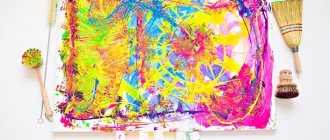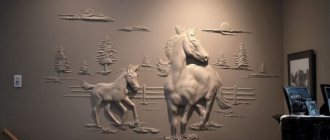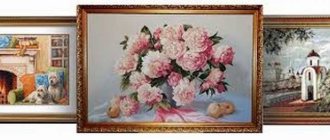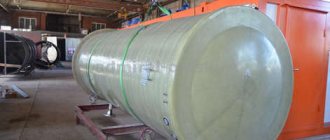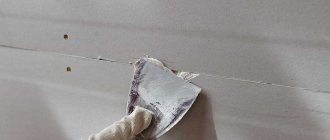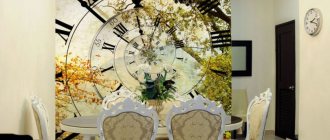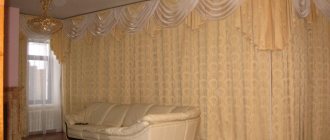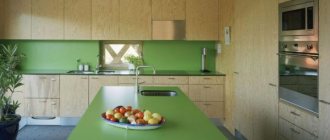Today you can easily make a picture yourself. For such creativity you do not need incredible talent, you just need to put in a little effort, desire and follow certain recommendations.
The painting will serve as an additional decorative element that will favorably emphasize the style of the room and its individuality.
Inspiration
Photos of handmade paintings show real works of art. This is a great way to transform your home with minimal funds and in a short period of time.
You should allocate time for this process, think about the technique, prepare equipment. It is important to think through everything to the smallest detail to translate the desired picture into reality.
Set a goal, visualize and create.
Fabric paintings
This method requires proper compilation. In this case, the paintings on the wall may not contain a clear storyline or meaning. Play out this situation.
Make a chic abstraction by hanging several fabrics of the same shape and size. It is only important to adhere to one rule: the paintings must be harmoniously combined with each other.
If something is already depicted on the fabric, then you should use it to create a composition with a plot. There is also a variant of modular paintings. Choose individual fabric fragments. They must intertwine and combine with each other.
Important! It is worth choosing the composition carefully and combining colors.
general information
In different countries of the world, with the development of weaving craft, people tried to make good use of every piece and scrap of fabric, the production of which required a lot of effort and labor. This is how patchwork sewing appeared.
Products made from sewn scraps of various materials were discovered during excavations in Egypt. Scientists dated the ornament made from pieces of leather found there to 980 BC.
Paintings made from fabric, scraps of fabric - birds and flowers
Paintings made from fabric, scraps of fabric - landscape
Paintings made from fabric, scraps of fabric - landscape
In England, products sewn from scraps appeared in 1712. In America in 1620, settlers from other countries brought quilts, which were sewn from scraps of old clothing. This marked the beginning of the production of scrap quilts. This technique is called quilt, which literally translates as quilting.
Later, applique from pieces of fabric appeared. The British began to use their crazy technique, which made it possible to create works from expensive fabrics and materials, using embroidery to connect parts.
The products were decorated with fringe, tassels, lace and ribbons. However, English technology did not take root in the world for long. In many countries around the world, craftsmen preferred traditional patchwork methods.
In the 70s last century in the USA there is a revival of interest in this handmade product. Whole hobby clubs began to appear, where quilting was practiced. Kits designed for this type of needlework with all the necessary attributes have appeared in stores. Some couturiers used the patchwork technique in their fashionable clothing designs.
Paintings made from fabric, scraps of fabric in the Russian style
Paintings made from fabric, scraps of fabric in the Russian style
Paintings made from fabric, scraps of fabric in the Russian style
In Russia back in the 16th century. in the collection of rules, advice and instructions called “Domostroy”, detailed instructions were given on how to cut and sew dresses from scraps, how to select scraps for cutting, how to sort and save them.
Patchwork reached its peak of development and application in Russia towards the end of the 19th century, when chintz began to be imported into the country from abroad. Until this time, this technique was used mainly for sewing quilts from old, worn items and was only of a practical nature.
At the beginning of the 20th century. Three-dimensional patchwork sewing techniques appeared in Rus'. At the same time, this type of applied creativity became one of those that was supported at the state level, like decorative and applied arts.
In the 90s interest in him increased with renewed vigor. Patchwork is no longer just a passion and a hobby. It becomes an independent genre in applied art. In Russia, since 1997, various festivals and exhibitions of works by real patchwork craftsmen have been regularly held.
Embroidered paintings
In the past, women were constantly involved in handicrafts. Despite the fact that in our time this tradition is not so popular, embroidery still attracts with its beauty today.
With the help of embroidery you can depict any story lines. Such a picture characterizes the person who embroidered it and shows diligence and talent.
Materials for work
What's so special about this technique:
- a 3D effect is created;
- quick execution, 3-4 hours is enough;
- no large investments are required, everything can be found in the creative workshop of any woman;
- such panels look good in any kitchen;
- this is a wonderful decoration for rooms in country or Provence style;
- You will always surprise your relatives and friends with a stylish gift.
For work, prepare:
- a sheet of foam plastic with a thickness of 2-2.5 cm and a density of 25;
- multi-colored scraps of thin fabric; coarse fabrics are not suitable for small details;
- sharp scissors;
- a diagram of the painting printed on a sheet of paper;
- carbon copy;
- stationery knife;
- felt-tip pen;
- PVA glue;
- ripper
Three-dimensional paintings
Creating three-dimensional paintings with your own hands requires time and some effort. Despite this, the end result will not keep you waiting.
First you need to prepare the wall. Make a sketch and objectively evaluate what needs to be corrected. Ask people close to you for the most accurate estimate.
Then prepare the putty and tie it in a container so that you can make a small hole in it. Smoothly trace the contours. With the help of an improvised pistol, the image will become convex.
You must wait until the drawing dries and becomes hard. If necessary, adjust the image and individual details.
To achieve a smooth surface, use sandpaper. Small grains will be ideal for the final work.
The next stage of how to make a painting with your own hands consists of a mixture of gouache and PVA glue. In order for the painting to last longer, you should decorate it with this mixture.
Decorate it with an improvised frame, the role of which will be played by special baguettes.
An interesting, but short-lived option is to create a picture using colored paper. It should be renewed from time to time and additional elements attached. You should cut out the silhouette you want and stick it on the wall in a certain order.
The figures can be transformed if desired with the help of additional elements, for example, interesting patterns. Silhouettes that differ in shape and color look best. Thus, your painting will be interesting and original in its execution.
Note! The paintings produced in this way fit harmoniously into the style of any room.
Their creation does not take much time, so you can get children to make them. In children's rooms, cats and other pets are often used to play on the steps.
Methods and rules for drying plants and flowers
Proper preparation of plant materials is one of the main points when collecting panels. Care must be taken to ensure that leaves, individual flowers, and bouquets retain their natural texture, color, and given shape for a long time. The duration of preservation of their color depends on the type of plant. Roses, dahlias, asters, and peonies will remain bright the longest. Pansies, nasturtiums, and succulents will quickly lose their natural color. It is better to store dried flowers in airtight containers made of glass or metal. Plants fade when exposed to sunlight, so they should be kept in a dark place. This rule also applies to finished panels.
Press drying
The easiest way to dry specimens is to place them under a press or in a special herbarium folder. If there are few decorative elements, they can be dried between the pages of a simple book. In addition, use office sheets, tracing paper or rice paper. The layers will protect the flowers from contact with printing ink. This method is only suitable for flat decorations.
First you need to prepare the sheets. Cut the A4 sheet in half and fold it into an envelope. We record the date of drying, location of discovery, and type of plant. We cut a leaf or flower, give it the desired shape (bend the stem, make slits). We put the raw materials in the pockets, straighten them and press them down a little. Place the envelope in the book and press down with a press.
If you need a lot of dried plants, you will have to use a special press. You can buy it in a store or make it yourself. We lay out flowers and leaves on a large piece of plywood or cardboard. Can be done in several layers. Then cover with a sheet of paper, cardboard and install the press. After 2-3 days, the layers need to be changed. Depending on the type of plant, it will take 5-20 days until it dries completely.
Hot express drying
To prevent the raw material for the panels from losing color and becoming dull during drying, it must be subjected to heat treatment. Young plants have the brightest colors. Before thorough drying, they must be ironed into the desired shape. The blanks are placed between two sheets and ironed with a hot surface until the moisture completely evaporates.
Several methods are used for quick drying. One of the simplest and most effective is moisture loss in the microwave. This method is suitable for flowers with a large number of petals (calendula, peony, dahlia). The plants are laid out on a plate, a container of water is placed next to it so that the floral decor does not fade, and the timer is set for 2 minutes. If the petals are not dry, you can roll them in a hot environment for another 1 minute. The degree of drying should be checked with a toothpick.
Drying in bouquets
Flowers or leaves are cut along with the stems and collected in bunches. It is better to tie with strips of thick fabric or twine. Such bouquets are turned upside down with buds and hung in a dark place. They should not touch any surfaces or each other. The same is done with single flowers on stems.
Bouquets of spikelets and fresh wildflowers can simply be laid out on paper in the open air. For bright and voluminous buds, a darkened room will be required to completely prevent them from fading. The drying process may take several days. During this time, the plants will lose moisture and decrease in size.
Volume drying
The main advantage of this method is the complete preservation of the appearance of the leaves or buds. In some types of plants, the natural color is perfectly preserved, and the green petals become more saturated and do not wrinkle. Volumetric drying takes place in several stages:
- We cut off the buds in dry weather. Carefully separate from the stem, maintaining 2 cm at the flower head. We insert a small piece of wire into the process;
- We prepare a container with a bulk substance that absorbs moisture. You can use semolina, salt, flour;
- Place the flowers, base down, on the bottom of the box. Carefully add desiccant, separating each petal. Close the lid and send to a dry, warm place;
- After 3-4 days, you need to check the degree of drying of the plants. To do this, lightly press the petals with the side of a toothpick;
- If the edges of the flower heads become hard to the touch, they can be removed. Using tweezers, we take out the buds one by one, blowing off the remaining bulk substance;
- We connect the buds to the stems using wire.
If the volumetric drying container is large and does not have a lid, it must be placed in a well-ventilated area.
Twine
Separately, I would like to note the art of creating paintings using an ordinary rope. You need to secure the rope in a vertical position, then secure it in the shape you want.
As a tool, use hot glue and invisible thread fasteners. This solution looks modern and stylish.
Applications create a certain volume to the picture. This is a special type of creativity that deserves attention.
It is necessary to choose a dense base, such as cardboard or plywood. They can be used in their original form, or covered with fabric. The color scheme depends on your desire.
Then proceed to attach additional components. Natural materials look quite interesting and fresh. For example, twigs of a dry tree.
Important! The peculiarity of this technique lies in the skill of thin fastening. Glue and additional fastening elements should not be visible to strangers. In the worst case, all the freshness and attractiveness of the picture will be ruined.
How to care for herbarium products
A supply of dried flowers that is waiting for its time must be stored correctly. If placed correctly and in ideal conditions, dried plants can last for decades. The following storage recommendations must be followed:
- Keep the box, folder, book with herbs and flowers only in a ventilated, dry room;
- Samples must be prepared according to their drying method. Flat ones are stored in a folder, voluminous ones in a box, bouquets - suspended in the open air;
- During long-term storage, each specimen must be treated once a year with insecticides against insects and other pests;
- Do not allow moisture to come into contact with dry samples;
- The storage area or container must be protected from direct sunlight.
conclusions
The value of homemade paintings is quite high today. There are a large number of manufacturing techniques. It is important to allocate a little time and effort in order to decorate the house with a homemade painting.
This process can be really fun if done as a family. Thus, using the means at hand, with minimal costs, you will show skill, originality, and decorate the room in an interesting way.
